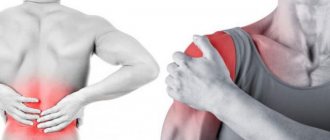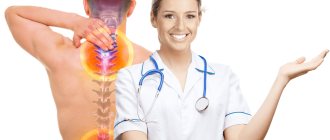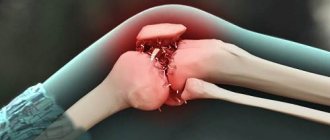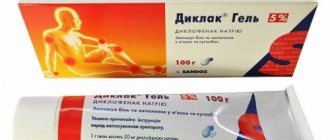Muscle fatigue
In our technological age, many people are gradually forming a new “bad habit”. Spending most of the day in front of a computer screen or holding mobile gadgets in our hands, we may not even notice that we are sitting in a completely uncomfortable and unnatural position. It especially affects the muscles of the shoulder girdle, neck, back and right arm, which is constantly on the computer mouse of office workers1. Staying in one position for a long time or using stereotyped movements can lead to overstrain of the muscles involved, which we feel as soreness1.
Exercise stress
“Body aches” after physical activity can occur both in untrained people and in professional athletes8. And the cause of discomfort is the accumulation of under-oxidized metabolic products in muscle cells; in particular, painful sensations are caused by an excessive amount of lactic acid (lactate)2. Less commonly, the cause is microtrauma, but this can only occur if the training rules are violated8.
Muscle soreness due to overwork does not occur immediately, but after a few hours or within 1-2 days after training or unusual physical activity and disappears within a week8.
Achieving speed of action
To achieve a therapeutic effect, an anesthetic drug for muscle pain
must have a number of characteristics - block the enzyme cyclooxygenase, due to which an anti-inflammatory
effect
, and accumulate quite quickly in the affected tissues.
Thanks to these properties, a modern painkiller can quickly relieve discomfort. A representative of this group of drugs, Next® contains a combination of analgesic components – ibuprofen and paracetamol, which have a complex effect on the peripheral and central mechanisms of pain pathogenesis, thus complementing each other’s biological effects. Next® is available in the dosage form of film-coated tablets for oral administration. This ensures fairly rapid* absorption of the active components into the systemic bloodstream with their subsequent penetration into both the site of injury and the nervous system. As a rule, painkillers for muscle pain
can quickly help cope with the pain. Preparations based on paracetamol and ibuprofen begin to have an analgesic effect on average 15-30 minutes** after administration.
Injuries
Severe pain can occur when muscle fibers and tendons are torn. This usually happens if the load is excessive and the muscles are not prepared for it1. But they can also be damaged by sudden movements3. Unlike “ache” due to muscle overwork, pain due to injury occurs immediately, at the peak of the load3.
It should be remembered that even a small, but untreated injury can cause an even more severe sprain3. Therefore, if you experience pain during physical activity, be sure to consult a doctor to rule out a serious injury.
to come back to the beginning
Features of the use of painkillers
Next® tablets have a favorable safety profile and are therefore approved for over-the-counter use. To get the maximum effect, namely reducing the severity of pain in the muscles, it is important to pay attention to several recommendations regarding the correct use of the drug:
- the therapeutic dose should not exceed the number of tablets indicated in the instructions;
- Next® tablets are not intended to treat the disease itself or the condition causing pain, they do not affect the mechanism of development of the disease, and also do not eliminate the impact of the causes of the pathological process. They are used as a means of symptomatic therapy - i.e. to reduce the severity of unpleasant symptoms;
- increased pain or discomfort or lack of effect within 3 days is the basis for a mandatory visit to a doctor who will prescribe the necessary examinations and treatment;
Next® are painkillers for muscle pain
inflammatory origin. Due to a special combination of active ingredients and dosage form, they help to quickly* reduce the severity of pain and relieve discomfort not only in the muscles, but in the joints, ligaments and other structures of the musculoskeletal system.
* According to the instructions for medical use of the drug Next® ** Moller P.L., Sindet-Pedersen S., Petersen S.T. et al. Onset of analgesic action of acetaminophen: comparison of oral and injection administration for postoperative analgesia. British Journal of Analgesia. May 2005, 94(5):642-8.
Back
Diseases of the spine and joints
Muscles react to disruption of the joints4 and vertebrae5 associated with them. Therefore, myalgia is one of the symptoms of diseases of the spine5,11 and joints of the limbs4. For example, with osteochondrosis or scoliosis (curvature of the spine), pain in the neck, chest or lower back is associated with overstrain of the paravertebral muscles5,11. And in advanced cases, when the vertebra compresses the nerve root emerging from the spinal cord, the pain can “radiate” to the arm or leg11.
Often myalgia with osteochondrosis is combined with a feeling of numbness or “crawling goosebumps”. At the moment of acute pain, a person freezes, taking a forced position11.
Side effects of NSAIDs
When discussing the use of NSAIDs, it is necessary to take into account the problem of side effects.
The structure-modifying properties of NSAIDs appear when they are taken over a long period of time in therapeutic doses. In this situation, the risk of developing complications specific to this class, mainly in the form of disturbances in the structure and function of the gastrointestinal tract and cardiovascular system (CVS), may become the main factor limiting the therapeutic potential of these drugs (Table 1) [5]. The most important complications include the so-called NSAID gastropathy (pathology of the upper gastrointestinal tract, manifested by clinically significant ulcers, bleeding and perforation) and cardiovascular accidents (myocardial infarction, ischemic stroke and sudden coronary death). Among these complications, NSAID-associated gastropathy has the greatest practical importance. This is a serious medical and social problem given the widespread use of NSAIDs [6].
Nephrotoxicity is the second most important group of adverse drug reactions of NSAIDs, which develops as a result of systemic non-selective suppression of prostaglandin synthesis, which leads to narrowing of the lumen of blood vessels and a decrease in renal blood flow. As a result, renal ischemia quickly develops, the glomerular filtration rate decreases, and the volume of diuresis decreases. There is a disturbance in water-electrolyte metabolism, which causes water retention in the body, edema, hypernatremia, hyperkalemia, the level of creatinine in the serum increases, and blood pressure rises. Hepatotoxicity with NSAIDs is rare. According to various estimates, in 1–4% of cases there is an asymptomatic moderate increase in the level of liver transaminases (ALAT, AST) [6].
Other reasons
Almost any disease of the internal organs can lead to myalgia11. When an organ is affected, it creates pain impulses that are partially transmitted to the muscles located nearby11.
Myalgia can also be caused by:
- endocrine diseases, such as thyroid hormone deficiency16,7;
- vascular pathologies that disrupt the nutrition of the muscles of the limbs15,16;
- chronic fatigue syndrome7;
- imbalance of microelements in the body16;
- taking medications that lower blood cholesterol levels12.
to come back to the beginning
Introduction
Nociceptive pain is one of the common clinical syndromes encountered by doctors of many specialties.
The most widely used drugs in the treatment of pain are from the group of nonsteroidal anti-inflammatory drugs (NSAIDs). Despite the presence of a seemingly huge arsenal of painkillers, the treatment of acute and chronic pain syndrome presents certain difficulties for practicing doctors due to the development of side effects. Thus, the currently available information about the unsafety of long-term use of NSAIDs leads to the need to search and develop new dosage forms and ways of their use. This review is devoted to this urgent problem and the search for ways to solve it.
NSAIDs have long taken a strong place in medical practice and are used for various pathologies. From a clinical point of view, they have some common properties:
anti-inflammatory effect;
analgesic and antipyretic effect;
inhibitory effect on platelet aggregation;
good tolerance.
Features of myalgia
Pain emanating from the muscles is usually deep6. Acute myalgia is protective in nature because it causes reactions aimed at eliminating the damaging factor11. Such reactions include, for example, muscle spasms4. But despite its protective nature, there is almost always a risk that the pain will become chronic11. There are 2 main causes of chronicity:
- Increased sensitivity. In response to irritation, the muscle releases substances that support inflammation. They further irritate pain receptors in the muscles. In response to frequent signals, the central nervous system lowers the pain threshold, so we can feel soreness in the muscle even when it is not strongly irritated11.
- Spasm. If pain and spasm persist, a “vicious circle” is formed: pain causes spasm, and spasm maintains pain1,5, 11.
Mechanism of action of painkillers
In most cases, pain reliever for muscle pain
is
anti-inflammatory
drug (NSAID).
The mechanism of the therapeutic effect is that it blocks the functional activity of the enzyme cyclooxygenase, which is responsible for the conversion of arachidonic acid into mediators of the inflammatory reaction, prostaglandins (they irritate nerve endings, causing pain). The severity of the anti-inflammatory effect varies among different representatives of this group of drugs. Also, these drugs can be produced in various dosage forms - tablets, ointment
, solution for parenteral administration.
The drug
Next® contains a combination of active ingredients, which has a pronounced analgesic effect due to its effect not only on inflammation and pain at the site of injury, but also on pain centers in the brain.
Diagnosis of muscle pain
Determining why myalgia occurs is not always easy. Only a doctor can understand the causes and select treatment that helps get rid of disturbing symptoms or alleviate them. To find out the cause of myalgia, the doctor conducts a comprehensive examination, including a neurological one, prescribes laboratory tests, ultrasound, computed tomography and other research methods3.
Various specialists treat myalgia. Depending on its cause, a traumatologist, rheumatologist, neurologist or endocrinologist can help you.
Choice of pharmacological therapy for spastic muscle hypertonicity
The main drugs used to reduce muscle tone are muscle relaxants. According to the mechanism of action, muscle relaxants are distinguished between central action (affect the synaptic transmission of excitation in the central nervous system) and peripheral action (inhibit the direct excitability of striated muscles). When using muscle relaxants, quite significant side effects can occur, which must be carefully assessed when choosing a drug [1, 2].
When choosing antispastic drugs, they mainly take into account their ability to inhibit polysynaptic reflexes (reducing spasticity), while having the least effect on monosynaptic reflexes (muscle strength). An antispastic drug should reduce muscle spasticity with a minimal decrease in muscle strength [3, 4].
Drug therapy is based on the use of tablet and injection forms. Antispastic agents used internally, by reducing muscle tone, can improve motor functions, facilitate care for an immobilized patient, relieve painful muscle spasms, enhance the effect of physical therapy, and prevent the development of contractures [5]. With mild spasticity, the use of muscle relaxants can lead to a significant positive effect, but with severe spasticity, large doses of muscle relaxants may be required, the use of which often causes unwanted side effects. Treatment with muscle relaxants begins with a minimum dose, then it is slowly increased to achieve effect [6].
The centrally acting muscle relaxants most often used in Russia for the treatment of spastic muscle hypertonicity include baclofen, tizanidine, tolperisone, and diazepam [7, 8].
Baclofen (Baklosan, Lioresal) has an antispastic effect mainly at the spinal level. The drug is an analogue of gamma-aminobutyric acid (GABA), which binds to presynaptic GABA receptors, leading to a decrease in the release of excitatory amino acids (glutamate, aspartate) and suppression of mono- and polysynaptic activity at the spinal level, which causes a decrease in spasticity. The drug also exhibits a moderate central analgesic effect. Baclofen is used for spinal and cerebral spastic muscle hypertonicity of various origins. The initial dose is 5–15 mg/day (in one or three doses), then the dose is increased by 5 mg every day until the desired effect is obtained. The drug is taken with meals. The maximum dose of baclofen for adults is 60–75 mg/day. Side effects often include sedation, drowsiness, decreased concentration, dizziness, and often subside during treatment. Nausea, constipation and diarrhea, arterial hypertension, increased ataxia, and the appearance of paresthesia may occur. Caution is required when treating elderly patients, patients who have had a stroke, patients with gastric and duodenal ulcers. Baclofen is contraindicated in case of epilepsy or a history of seizures [9, 10].
For severe spasticity, when the usual oral use of antispastic drugs is not effective, intrathecal administration of baclofen is indicated, which was first proposed in 1984 by R. Penn. To achieve the required concentration of the drug in the cerebrospinal fluid, it is necessary to take quite significant doses of baclofen, which can lead to disturbances of consciousness, drowsiness, and weakness. Therefore, systems have been developed that deliver baclofen directly into the intrathecal space of the spinal cord using the intrathecal baclofen pump system. In this case, the clinical effect is achieved with much smaller doses of baclofen than when using tablet forms [11, 12].
This system consists of a reservoir containing baclofen or a similar drug, a pump (pump), with the help of which the drug is dosed into the intrathecal space of the spinal cord through a lumbar catheter and a power supply. From the reservoir, baclofen enters directly into the cerebrospinal fluid, and its dosage is controlled by a special radiotelemetry device. The amount of drug entering the cerebrospinal fluid can be changed depending on the clinical picture. Baclofen is added to the reservoir after 2–3 months using percutaneous puncture [13].
The use of a baclofen pump improves the speed and quality of walking of patients with unfixed reflex contractures caused by high spasticity of synergistic muscles and imbalance of antagonist muscles. The existing 15-year clinical experience of using baclofen intrathecally in patients who have suffered a stroke indicates the high effectiveness of this method in reducing not only the degree of spasticity, but also pain syndromes and dystonic disorders. A positive effect of the baclofen pump on the quality of life of stroke patients was noted [14].
Tizanidine (Sirdalud) is a centrally acting muscle relaxant, an alpha-2 adrenergic receptor agonist. The drug reduces spasticity due to suppression of polysynaptic reflexes at the level of the spinal cord, which can be caused by inhibition of the release of excitatory amino acids L-glutamate and L-aspartate and activation of glycine, which reduces the excitability of spinal cord interneurons. Tizanidine also has a moderate central analgesic effect. The drug is effective for cerebral and spinal spasticity, as well as for painful muscle spasms. The initial dose of the drug is 2–6 mg/day in one or three doses; with individual selection, the dose is increased on days 3–4 by 2 mg. When taken orally, the effect of the drug appears within 30–45 minutes, the maximum effect occurs within 1–2 hours. The average therapeutic dose is 12–24 mg/day, the maximum dose is 36 mg/day. Side effects may include drowsiness, dry mouth, dizziness and decreased blood pressure, which limits the use of the drug for post-stroke spasticity. The antispastic effect of tizanidine is comparable to the effect of baclofen, however, tizanidine, with adequate dosage selection, is better tolerated, since it does not cause general muscle weakness and does not increase muscle weakness in the paralyzed limb [15, 16].
Tolperisone (Mydocalm) is a centrally acting antispastic drug that inhibits the caudal part of the reticular formation and has N-cholinolytic properties. Tolperisone reduces the activity of spinal neurons involved in spasticity by limiting the flow of sodium across the nerve cell membrane. The most commonly used dose is 300–450 mg/day in two or three doses. A decrease in muscle tone when tolperisone is prescribed is sometimes accompanied by a vasodilator effect, which should be taken into account when prescribing to patients with a tendency to arterial hypotension. The drug can also cause or worsen urinary incontinence in patients [17].
The main side effect of baclofen, tizanidine and tolperisone is the rapid onset of muscle weakness, and in each case the doctor must find a balance between decreased tone and increased weakness. The balance curve between a decrease in spastic tone and an increase in muscle weakness in patients with an increase in the dose of Mydocalm, Sirdalud or Baclofen shows that the most rapid increase in weakness occurs when taking Baclofen, and the mildest drug that allows you to effectively select an individual dosage is Mydocalm. In all cases, given the presence of a narrow therapeutic window, the course of treatment begins with a small dose of the drug, gradually increasing it until a clear antispastic effect is achieved, but not until weakness appears [18, 19].
Diazepam (Realanium, Relium, Sibazon) is a muscle relaxant because it has the ability to stimulate reduced presynaptic inhibition at the spinal level. It does not have direct GABAergic properties, increases the concentration of acetylcholine in the brain and inhibits the reuptake of norepinephrine and dopamine at synapses. This leads to increased presynaptic inhibition and is manifested by a decrease in stretch resistance and an increase in range of motion. Diazepam also has the ability to reduce pain caused by muscle spasms. Along with a decrease in muscle tone, lethargy, dizziness, impaired attention and coordination develop due to the toxic effect on the central nervous system. This significantly limits the use of diazepam as a muscle relaxant. It is used mainly for the treatment of spasticity of spinal origin when a short-term decrease in muscle tone is necessary. For the treatment of spasticity, a dose of 5 mg once or 2 mg 2 times a day is prescribed. The maximum daily dose can be 60 mg. At high doses, disturbances of consciousness, transient liver dysfunction and blood changes may occur. The duration of treatment is limited due to the possible development of drug dependence [20].
Clonazepam is a benzodiazepine derivative. Clonazepam has a sedative, central muscle relaxant, and anxiolytic effect. The muscle relaxant effect is achieved by enhancing the inhibitory effect of GABA on the transmission of nerve impulses, stimulating benzodiazepine receptors located in the allosteric center of the postsynaptic GABA receptors of the ascending activating reticular formation of the brain stem and interneurons of the lateral horns of the spinal cord, as well as reducing the excitability of the subcortical structures of the brain and inhibition of polysynaptic spinal reflexes.
The rapid onset of drowsiness, dizziness and addiction limits the use of this drug. To reduce the occurrence of possible adverse reactions, it is necessary to achieve a therapeutic dose by slow titration over two weeks. For oral administration to adults, an initial dose of no more than 1 mg/day is recommended. Maintenance dose: 4–8 mg/day. It is possible to prescribe small doses in combination with other muscle relaxants. Clonazepam is effective for paroxysmal increases in muscle tone. Contraindicated in acute diseases of the liver, kidneys, myasthenia gravis [21].
Dipotassium clorazepate (Tranxen) is a benzodiazepine analogue, transforms into the main metabolite of diazepam, has greater activity and duration of antispastic action than diazepam. It has been noted to have a good effect in treatment in the form of a decrease in phasic stretch reflexes and has a slight sedative effect. The initial dose is 5 mg 4 times a day, then reduced to 5 mg 2 times a day [22].
Dantrolene is an imidazoline derivative that acts outside the central nervous system, mainly at the level of muscle fibers. The mechanism of action of dantrolene is to block the release of calcium from the sarcoplasmic reticulum, which leads to a decrease in the degree of contractility of skeletal muscles, a reduction in muscle tone and phasic reflexes, and an increase in the range of passive movements. An important advantage of dantrolene in relation to other muscle relaxants is its proven effectiveness against spasticity not only of spinal, but also of cerebral origin. The initial dose is 25 mg/day; if tolerated, the dose is increased over 4 weeks to 400 mg/day. Side effects: drowsiness, dizziness, nausea, diarrhea, decreased glomerular filtration rate. A serious danger, especially in elderly patients at a dose of more than 200 mg/day, is the hepatotoxic effect, so liver function should be regularly monitored during treatment. Elimination of dantrolene is 50% due to hepatic metabolism, and therefore it is contraindicated in liver diseases. Caution should also be exercised in case of severe cardiac or pulmonary diseases.
Catapresan - used mainly for spinal injuries, acts on alpha-2 agonists in the brain, has presynaptic inhibition. Side effects include decreased blood pressure and depression. The initial dose is 0.05 mg 2 times a day, the maximum is 0.1 mg 4 times a day.
Temazepam - interacts with benzodiazepine receptors of the allosteric center of postsynaptic GABA receptors located in the limbic system, ascending activating reticular formation, hippocampus, interneurons of the lateral horns of the spinal cord. As a result, channels are opened for incoming currents of chlorine ions and thus the action of the endogenous inhibitory transmitter, GABA, is potentiated. The recommended dose is 10 mg 3 times a day. Its combination with baclofen is effective [23, 24].
The main drugs used to treat spastic muscle hypertonicity are presented in Table.
Thus, the choice of drug is determined by the underlying disease, the severity of muscle spasticity, as well as side effects and characteristics of the action of a particular drug.
For example, tizanidine and baclofen have a greater effect on the tone of the extensor muscles, therefore, in cases of significant hypertonicity of the flexor muscles of the arm, mild spasticity of the leg muscles, their use is not indicated, since a slight increase in the tone of the extensor muscles of the leg compensates for muscle weakness in the leg and stabilizes the patient's gait. In this case, the means of choice are methods of physical impact on the muscles of the upper limb.
In the treatment of cerebral spasticity, Sirdalud and Baclofen are most often used, and for spinal spasticity - Sirdalud and Baclofen. Mydocalm has an important advantage over other muscle relaxants, which does not have a sedative effect and has a favorable tolerability spectrum, therefore it is the drug of choice for treatment on an outpatient basis and for the treatment of elderly patients.
A combination of several drugs is acceptable, which allows you to effectively reduce tone at lower doses of each drug. Combining drugs with different points of application, from centers in the brain to muscles, can lead to a cumulative therapeutic effect.
The effectiveness of oral antispastic drugs decreases with their long-term use; there is often a need for increasing dosages to maintain the initial clinical effect, which is accompanied by an increase in the frequency and severity of adverse reactions [25–27].
In a situation where spasticity is local in nature and the systemic effect of oral muscle relaxants is undesirable, local methods of exposure are preferable, one of which is the local administration of botulinum toxin [28, 29].
Literature
- Skoromets A. A., Amelin A. V., Pchelintsev M. V. et al. Prescription reference book for a neurologist. SPb: Polytechnic. 2000. 342 p.
- Shtok V.N. Pharmacotherapy in neurology: A practical guide. 4th ed., revised. and additional M.: Medical Information Agency LLC, 2006. 480 p.
- Methodological recommendations for organizing neurological care for patients with strokes in St. Petersburg / Ed. V. A. Sorokoumova. SPb: St. Petersburg, 2009. 88 p.
- Lehmann-Horn F., Ludolf A. Treatment of diseases of the nervous system. M.: MEDpress-inform. 2005. 528 p.
- O'Dwyer N., Ada L., Neilson P. Spasticity and muscle contractur in stroke // Brain. 2006. Vol. 119. P. 1737–1749.
- Damulin I.V. Spasticity syndrome and the main directions of its treatment // Journal of Neurology and Psychiatry named after. S. S. Korsakova. 2003. No. 12. P. 4–9.
- Zavalishin I. A., Barkhatova V. P., Shitikova I. E. Spastic paresis // In the book. Multiple sclerosis. Selected issues of theory and practice. Ed. I. A. Zavalishina, V. I. Golovkina. Elf IPR LLC. 2000. pp. 436–455.
- Levin O. S. Basic drugs used in neurology: Handbook. M.: MEDpress-inform, 2007. 336 p.
- Boyko A. N., Lashch N. Yu., Batysheva T. T. Increased muscle tone: etiology, pathogenesis, correction // Handbook of a polyclinic doctor. 2004. T. 4. No. 1. P. 28–30.
- Damulin I.V. Spasticity syndrome and the main directions of its treatment // Journal of Neurology and Psychiatry named after. S. S. Korsakova. 2003. No. 12. P. 4–9.
- Selected lectures on neurology: ed. V. L. Golubeva. M.: EidosMedia, 2006. 624 p.
- Parziale J., Akelman E., Herz D. Spasticity: pathophysiology and management // Orthopedics. 2003. Vol. 16. P. 801–811.
- Katz R., Rymer Z. Spastic hypertonia: mechanisms and measurement // Arch. Phys. Med. Rehab. 2009. Vol. 70. P. 144–155.
- Barnes M. An overview of the clinical management of spasticity // In: Upper motor neuron syndrome and spasticity. Cambridge University Press. 2001. P. 5–11.
- Parfenov V. A. Pathogenesis and treatment of spasticity // Russian Medical Journal. 2011. T. 9. No. 25. pp. 16–18.
- Kadykov A. S., Shakhparanova N. V. Drug rehabilitation of patients with spastic paresis. In the book: Upper motor neuron syndrome. Ed. I. A. Zavalishina, A. I. Osadchikh, Y. V. Vlasova. Samara: Samara department. Literary Fund, 2005. pp. 304–315.
- Kadykov A. S., Chernikova L. A., Sashina M. B. Rehabilitation of patients with central post-stroke pain syndrome // Rehabilitation. Collection of scientific works (annual publication), No. 1. M.: Publishing house RGMU, 2003. P. 357–359.
- Sashina M. B., Kadykov A. S., Chernikova L. A. Post-stroke pain syndromes // Atmosphere. Nervous diseases. 2004. No. 3. P. 25–27.
- Kamchatnov P.R. Spasticity - modern approaches to therapy // Russian Medical Journal. 2004. T. 12. No. 14. P. 849–854.
- Gusev E.I., Skvortsova V.I., Platinova I.A. Therapy of ischemic stroke // Consilium medicum. 2003, special release. pp. 18–25.
- Kadykov A. S., Chernikova L. A., Sashina M. B. Post-stroke pain syndromes // Neurological Journal. 2003. No. 3. P. 34–37.
- Musaeva L. S., Zavalishin I. A. Treatment of spasticity in multiple sclerosis // Proceedings of the 9th symposium “Multiple sclerosis: treatment and recovery.” SPb: Faces of Russia. 2000. pp. 59–60.
- Stroke. Principles of diagnosis, treatment and prevention / Ed. N.V. Vereshchagina, M.A. Piradova, Z.A. Suslina. M.: Intermedica, 2002. 208 p.
- Sommerfeld DK, Eek EU-B., Svensson A.-K. et al. Spasticity after stroke: its occurrence and association with motor impairments and activity limitations // Stroke. 2004. Vol. 35. P. 134–140.
- Bakheit A., Zakine B., Maisonobe P. The profile of patients and current practice of treatment of upper limb muscle spasticity with botulinum toxin type A // Int. J. Rehabil. Res. 2010. Vol. 33. P. 199–204.
- Malakhov V. A. Muscular spasticity in organic diseases of the nervous system and its correction // International Neurological Journal. 2010. No. 5. P. 67–70.
- Davis T., Brodsky M., Carter V. Consensus statement on the use of botulinum neurotoxin to treat spasticity in adults // Pharmacy and Therapeutics. 2006. Vol. 31. P. 666–682.
- Childers M., Brashear A., Jozefczyk P. Dose-dependent response to intra-muscular botulinum toxin type A for upper limb spasticity after stroke // Arch. Phys. Med. Rehab. 2004. Vol. 85. P. 1063–1069.
- Kadykov A. S. Muscle relaxants in the rehabilitation of patients with post-stroke motor disorders // Journal of Neurology and Psychiatry named after. S. S. Korsakova. 1997. No. 9. pp. 53–55.
A. A. Korolev, Candidate of Medical Sciences
FSBI All-Russian Center for Emergency and Radiation Medicine named after. A. M. Nikiforova" EMERCOM of Russia, St. Petersburg
Contact information about the author for correspondence







